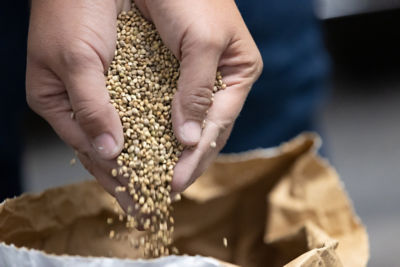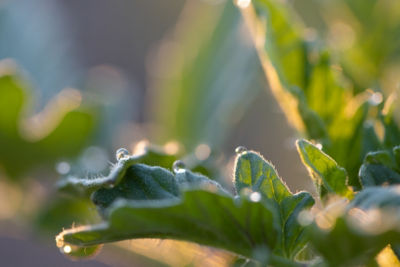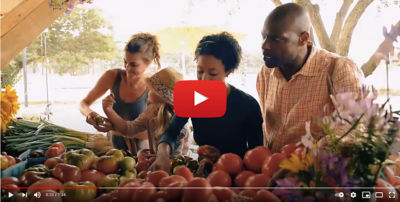Click here to download a PDF version of this Cultivation Insights article.
» Cucumber fruit production and quality are affected by lower light levels of late fall in northern locations.
» Lower light intensity levels and shorter photoperiods in the fall result in reductions in photosynthesis and plant growth.
» Selection of trellising sytems, cucumber varieties, environmental conditions, and greenhouse design can help fall production
Light Conditions
As cucumber production transitions from summer to fall conditions, the cucumber plants need to adapt to growing in a lower light environment, especially in operations that do not use supplemental lighting during the fall and winter months. Cucumbers are day-length neutral plants, meaning that they do not require short- or long-day photoperiods to induce flowering.1 However, the physiology and growth of cucumber plants do change with changing light conditions. The cumulative amount of light that a plant receives depends on the light intensity and photoperiod (how much and for how long).2 Light intensity is the number of photons hitting a surface. In greenhouse operations, this is usually measured as moles of light per square meter (mol/m2 ) or micromoles of light per square meter (µmol/m2 ). This is an instantaneous measure of light intensity, a snapshot of the amount of light hitting a surface at any given time. For a cumulative measure of light, we add up the amount of light hitting a surface over a specific amount of time, such as per second (µmol/m2 /s) or per day (mol/m2 /d). The daily (24-hour) measurement is called the daily light integral (DLI).3 The DLI is affected by the intensity of light and day length. In the summer months, the light from the sun is very intense, and day lengths are long, resulting in high DLI values. As we move into the fall, the intensity of sunlight is reduced, and day lengths are shorter, resulting in lower DLI values. The DLI for a region, such as the greater Toronto area in Ontario, can range from 1 mol/m2 /d in the winter months to 35 mol/m2 /d in the summer (Figure 1).2

Plants use the energy from light to produce food (sugar) through the process of photosynthesis. Plants only use light in the photosynthetically active range of radiation (PAR) that includes the blue through red parts of the spectrum of visible light. Blue and red wavelengths of light are the most important for photosynthesis.3 The intensity and ratios of blue, red and far-red light affect a plant’s growth and flowering behaviors. Only light in the PAR part of the spectrum is used when calculating the DLI for a location, and DLI levels inside a greenhouse are 40 to 70% lower than the outside levels, depending on the structure, orientation, and covering material of the greenhouse.3
Cucumber Light Response
Cucumbers are day-neutral plants or photoperiod indeterminate; however, cucumber growth and flowering are affected by day length. Long days tend to induce the production of male flowers over female flowers for varieties that produce both types, but varieties that are insensitive to photoperiod have been developed.1,4 Shorter day lengths tend to result in longer and thinner stems. Day length also affects the size of developing leaves. One study found that leaf area was greatest with twelve hours of daylight, and smaller leaf areas were seen with both longer (16-hour) and shorter (8-hour) photoperiods. However, a sixteen-hour photoperiod resulted in plants with larger root systems and increased levels of branching.1
Cucumbers require relatively high light intensity levels for the highest yield potentials, and DLI levels should be in the range of 20 to 30 mol/m2 /d. The optimum DLI for cucumber is 30 mol/m2 /d, and the minimum is 15 mol/m2 /d. There can even be some reabsorption of sugars from the fruit back into the vine at very low light levels.4,5,6 Lower DLI levels result in reductions in root and shoot growth, lower levels of branching, increased time to flowering, and reductions in the number and size of flowers.7 If light levels are too low, plants cannot generate enough photosynthates (food) to supply the needs of the roots, stems, leaves, and fruit. Under low light conditions, plants will try to produce larger and thinner leaves to collect more light (moving into a vegetative mode). This physiological change reduces resources going to the root system and can result in root decay.8,9 The level of response to low light depends on the age of the plant. Younger plants and younger leaves respond to low light conditions more rapidly than do older plants and leaves.
Plants started in the winter (January) respond to low light levels in the early spring more quickly than plants started in the late summer (August) respond to lower light levels later in the fall.
Light levels also affect cucumber fruit length, color, and shelf life. The shelf life of cucumber fruit is positively correlated to fruit skin chlorophyll concentration. Darker colored fruit contain more chlorophyll in their skin and have a longer shelf life. Chlorophyll content in the skin goes down at lower light levels, reducing shelf life. Fruit produced in low light conditions also tend to be shorter than are fruit produced with abundant light.11,12
With the vertical growing systems use in greenhouse cucumber production, the upper canopy starts to shade the lower canopy as the plant grows toward the overhead wire. As canopies develop, the lower leaves lose photosynthetic capacity as they become shaded by the upper leaves.10 The amount of shading will depend on the design of the system, high-wire vs. umbrella. In high-wire systems, the vines are periodically lowered, and the lower, less productive leaves are removed. Plants in highwire systems tend to have smaller leaves and canopies are usually more open, leading to less self-shading that occurs with umvrella systems.13 So, low light levels may have less of an effect in high-wire systems.
Indications that light low levels are affecting growth include larger, thinner leaves; longer, thinner internodes, fewer flowers, delayed flower initiation, and shorter, paler fruit. Leaf yellowing and necrosis are indications low light that are fairly easy to detect. Some growers and scouts use a nine-point scale (1=absent to 9=severe) to rate the level of necrosis due to low light levels.
Managing Production in Low Light Conditions
There are means by which growers can help maximize the production and quality of cucumber fruit in low light conditions. One way is to select a cultural system that increases the amount of light reaching the lower canopy area. Lowering planting density helps open canopies and allows more light to penetrate to lower levels. Selecting training and pruning practices that increase the exposure of the lower leaves to sunlight is also important. Cucumber varieties also vary in their response to low light conditions. Varieties with smaller leaves allow more light to reach the lower canopy. Larger leaf varieties can capture more light, but they require greater spacing to allow adequate light penetration.10 Low light levels also cause cucumber plants to grow more vegetatively rather than generatively (producing fruit). Selecting varieties that tend to be more generative will help the plants to maintain generative growth in low light conditions.
Adjusting environmental factors that push plants toward generative growth can also be used to help plants adapt to low light levels. Temperature, CO2 concentrations, humidity levels, irrigation frequency and duration, and fertilization levels all interact to influence the balance between vegetative and generative growth. Increased concentrations of CO2 can maintain growth rates at low light levels. Maintaining a similar growth rate with 30% less light can be achieved by increasing CO2 levels from ambient (365 ppm) to 800 ppm.5,8
With lower light levels, reducing the daytime temperature to as low as 21°C (70°F), depending on light level, can help keep plants in a generative growth phase. Also, because plants are not transpiring as much in low light, reduce irrigation drainlevels to prevent waterlogging, and increase the EC values of the hydroponic solution (feed to 3.0 mmhos and leach to 4.0 mmhos). Maintaining relative humidity levels in the 55% to 75% range will help plants maintain dry matter production. Avoid rapid changes in temperature and humidity to prevent problems with edema.8,11
Greenhouse design also affects light levels inside the house. Light level reductions of about ten percent are seen with each layer of covering. However, the amount of reduction also depends on the material used for the cover and the angle of incident light. Glass, D-poly, and acrylic materials are commonly used to cover houses. Using a material that allows the greatest transmission of light that is used for photosynthesis (blue, red, and far-red light) will help maintain plant growth, fruit production, and fruit quality. The highest dry matter production levels are often seen in houses covered with glass.11
Sources
1 Danielson. L. 1944. Effect of day-length on growth and reproduction of the cucumber. Plant Physiol. 19:638-648.
2 Dorais, M. 2003. The use of supplemental lighting for vegetable crop production: Light intensity, crop response, nutrition, crop management, cultural practices. In Proceedings of the Canadian Greenhouse Conference, Niagra Falls, ON, Canada, 9 October 2003: 1-8.
3 Understanding the light in your horticultural crops, basics about lighting and plant production. Hort Americas. Hortamericas.com. https://youtu.be/mihHJODiC-w.
4 Wehner, Todd C.; Naegele, Rachel P.; Myers, James R.; Dhillon, Narinder P.S.; Crosby, Kevin. Cucurbits, 2nd Edition (Crop Production Science in Horticulture) (pp. 213-214). CABI.
5 Moe, R., Grimstad, S., and Gislerød, H. 2006. The use of artificial light in year round production of greenhouse crops in Norway. Acta Hortic. 711:35-42.
6 Daily light integral: Are your plants receiving the right amount of light? Hort Americas. https://hortamericas.com/blog/science/daily-light-integral-how-much-light-do-i-need/.
7 Torres, A., Currey, C., and Lopez, R. 2010. Measuring daily light integral (DLI). Purdue Extension, HO-238-B-W.
8 Mirza, M. 2017. Supplemental lighting challenges. Greenhouse Canada. https://www.greenhousecanada.com/structures-equipment/lighting/supplemental-lightingchallenges-31712.
9 Ontario Ministry of Agriculture, Food and Rural Affairs. 2010. Growing greenhouse vegetables in Ontario. Publication 836.
10 Pettersen, R., Torre, S., and Gislerød, H. 2010. Effects of leaf aging and light duration on photosynthetic characteristics in a cucumber canopy. Sci. Hortic. 125: 82-87.
11 Hao, X. and Papadopoulos, A. 1999. Effects of supplemental lighting and cover materials on growth, photosynthesis, biomass partitioning, early yield and quality of greenhouse cucumber. Sci. Hortic. 80: 1-18.
12 Lin, W., and Jolliffe, P. 1996. Light intensity and spectral quality affect fruit growth and shelf life of greenhouse-grown long English cucumber. J. Amer. Soc. Hort. Sci. 121(6):1168–1173.
13 Mohammad, A. 2020. How high-wire growing can take cucumbers to the next level. Greenhouse Grower. https://www.greenhousegrower.com/production/vegetablesproduction/how-high-wire-growing-can-take-cucumbers-to-the-next-level/.
Websites verified 9/15/2021
Additional Information
For additional agronomic information, please contact your local seed representative.
Performance may vary, from location to location and from year to year, as local growing, soil and weather conditions may vary. Growers should evaluate data from multiple locations and years whenever possible and should consider the impacts of these conditions on the grower’s fields. The recommendations in this article are based upon information obtained from the cited sources and should be used as a quick reference for information about greenhouse cucumber production. The content of this article should not be substituted for the professional opinion of a producer, grower, agronomist, pathologist and similar professional dealing with this specific crop.
BAYER GROUP DOES NOT WARRANT THE ACCURACY OF ANY INFORMATION OR TECHNICAL ADVICE PROVIDED HEREIN AND DISCLAIMS ALL LIABILITY FOR ANY CLAIM INVOLVING SUCH INFORMATION OR ADVICE. 9057_DR_S24
Published 09-30-2021
Bayer, Bayer Cross and De Ruiter® are registered trademarks of Bayer Group. All other trademarks are the property of their respective owners. ©2021 Bayer Group. All rights reserved.



